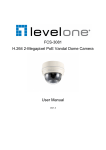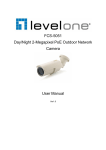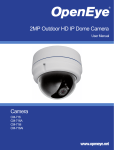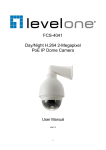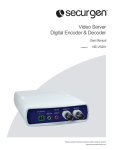Download GV-NC-201B USER MANUAL
Transcript
GV-NC-201B H.264 Megapixel Network Box Camera USER MANUAL WWW.GVISS.COM Table of Contents 1. Overview.................................................................................................................... 3 2. Introduction of IP Camera..................................................................................... 4 3. Preparations for IP Camera Setup........................................................................ 6 4. 1.1 1.2 2.1 2.2 3.1 3.2 3.3 Features..........................................................................................................................................................3 Package Contents........................................................................................................................................3 Camera Dimensions....................................................................................................................................4 Connectors on the Rear Board................................................................................................................4 System Requirements.................................................................................................................................6 Installation.....................................................................................................................................................6 Accessing IP Camera...................................................................................................................................7 Configuration & Operation.................................................................................... 13 4.1 4.2 4.3 4.3.1 4.3.2 4.3.3 4.3.4 4.3.5 4.3.6 4.3.7 4.3.8 4.3.9 4.3.10 4.3.11 4.3.12 4.3.13 4.3.14 4.4 4.4.1 4.4.2 4.4.3 4.4.4 4.4.5 4.5 4.5.1 4.5.2 4.5.3 4.5.4 4.5.5 4.5.6 4.5.7 4.5.8 4.5.9 4.5.10 4.6 Browser-based Viewer Introduction........................................................................................................13 Home Page....................................................................................................................................................14 System Related Settings.............................................................................................................................15 Host Name and System Time Setting......................................................................................................16 Security..........................................................................................................................................................17 Network........................................................................................................................................................19 DDNS.............................................................................................................................................................22 Mail..................................................................................................................................................................23 FTP..................................................................................................................................................................24 Application (Excluding Compact IP Dome)...........................................................................................24 Snapshot.........................................................................................................................................................28 View Log File.................................................................................................................................................29 View User Information...............................................................................................................................30 View Parameters..........................................................................................................................................32 Factory Default............................................................................................................................................32 Software Version..........................................................................................................................................33 Software Upgrade........................................................................................................................................34 Video and Audio Streaming Settings........................................................................................................36 Video Resolution and Rotate Type...........................................................................................................37 Video Compression....................................................................................................................................39 Video OCX Protocol..................................................................................................................................40 Video Frame Skip.........................................................................................................................................41 Audio Mode and Bit Rate Settings...........................................................................................................42 Camera Settings...........................................................................................................................................43 Exposure Setting..........................................................................................................................................44 White Balance Setting.................................................................................................................................45 Backlight Setting...........................................................................................................................................45 Brightness Setting........................................................................................................................................46 Sharpness Setting.........................................................................................................................................46 Contrast Setting...........................................................................................................................................46 Digital Zoom Setting...................................................................................................................................46 WDR Function.............................................................................................................................................46 3DNR Function............................................................................................................................................47 TV System Setup..........................................................................................................................................47 Logout............................................................................................................................................................47 Appendix A: Technical Specifications..................................................................................... 48 Appendix B: Internet Security Settings................................................................................. 49 Appendix C: DC Viewer Download Procedure................................................................. 52 Appendix D: Back Focus Adjustment.................................................................................... 54 GVI Security • Toll Free: 888-595-2288 • Fax: 972-245-7333 2 This product specifications and manual are also available in pdf format at www.gviss.com The information is subject to change without notice • v4.29.10 1. Overview The autoIP™ GV-NC-201B network camera provides high quality, 1.3 megapixel resolution video in the most demanding light conditions. High video quality is achieved by coupling a 1/3” Ex-View-HAD CCD progressive scan image sensor with an IR cut filter and Wide Dynamic Range capability. H.264 compression retains the high video quality at a low data rate to reduce storage and bandwidth requirements. Power over Ethernet (PoE) reduces installation time and costs. The camera is compatible with the user-friendly autoIP™ open platform video management software for quick plug and play installation. 1.1 Features • Resolution: 1.3MP (1280x960) • 1/3” Ex-View-HAD Progressive Scan CCD • C/CS Mount Lens • Multiple Codec (H.264, MPEG-4, MJPEG) • Simultaneous Dual Codec Support • Wide Dynamic Range • True Day/Night with IR Cut Filter • 3D Noise Reduction • Audio • Privacy Masks • Flip, Mirror, Rotate Functions • Micro SD Card Support • Analog Output • PoE / DC12V / AC24V *Features might be different from model selection. 1.2 Package Contents The HD WDR IP Camera’s standard package contains the items as shown below. Contents will vary among different models. Please check the list as follows for details. autoIP™ Box Camera CD (bundled software and documentation) Back focus adjuster Power terminal block Quick Guide GVI Security • Toll Free: 888-595-2288 • Fax: 972-245-7333 This product specifications and manual are also available in pdf format at www.gviss.com The information is subject to change without notice • v4.29.10 3 2. Introduction of IP Camera This chapter will provide the camera dimensions for reference before installation. Definition of each connector on the camera’s rear board will also be specified. 2.1 Camera Dimensions The IP Camera’s dimensions are as shown below: 3.23” 2.09” 4.92” 2.2 Connectors on the Rear Board The diagram below shows the IP Camera’s rear board. Definition for each connector will be given as follows. Network LEDs Power LED Reset Button Power Connector GVI Security • Toll Free: 888-595-2288 • Fax: 972-245-7333 4 This product specifications and manual are also available in pdf format at www.gviss.com The information is subject to change without notice • v4.29.10 Line Out & Line In / Mic In ports For two-way audio transmission Power LED Green light indicates good power connection. Reset Button Press and hold the button for 5 seconds, and then the camera will reset to factory defaults. After around 30 seconds, the camera will be available to be discovered in DHCP mode. Auto Iris Lens Connector For use with auto iris lens Network (with PoE) Connector RJ45 connector for LAN connection Network LEDs Green Link Light indicates good network connection. Orange Activity Light flashes for network activity indication. I/O Terminal Connector For alarm connection (see section 3.2: Installation—Alarm Application) BNC Connector For video output Micro SD Card Slot For video and snapshots storage AC 24V/DC 12V Connector Please refer to the table below for wiring of AC 24V and DC 12V camera with the supplied power cable. AC 24V: Power-1 AC 24V: Earth GND AC 24V: Power-2 DC 12V: Power DC 12V: Reserved DC 12V: GND GVI Security • Toll Free: 888-595-2288 • Fax: 972-245-7333 This product specifications and manual are also available in pdf format at www.gviss.com The information is subject to change without notice • v4.29.10 5 3. Preparations for IP Camera Setup This chapter outlines information about system requirements for IP Camera operation, procedures of camera connection, and login to the camera. 3.1 System Requirements To perform the IP Camera via web browser, please ensure your PC has a good network connection, and meets system requirement as described below. Items System Requirement Personal Computer 1. Intel® Pentium® M, 2.16 GHz or Intel® CoreTM2 Duo, 2.0 GHz, 2. 2 GB RAM or more Operating System Windows VISTA or Windows XP, Windows 7 Web Browser Microsoft Internet Explorer 6.0 or later Network Card 10Base-T (10 Mbps) or 100Base-TX (100 Mbps) operation Viewer ActiveX control plug-in for Microsoft IE 3.2 Installation Please follow the instructions below to complete IP Camera installation. Lens Mounting: C/CS Mount Lens Model To use C-Mount lens, user needs to mount the C/CS mount adapter to the camera, and then attach the lens onto the C/CS mount adapter, as the illustrations shown below. C/CS Mount Adapter Completion Power Connection Please refer to section 2.2 Connectors on the Rear Board for power wiring. Additionally, if using PoE, make sure Power Sourcing Equipment (PSE) is in use in the network. GVI Security • Toll Free: 888-595-2288 • Fax: 972-245-7333 6 This product specifications and manual are also available in pdf format at www.gviss.com The information is subject to change without notice • v4.29.10 Ethernet Cable Connection Use of Category 5 Ethernet cable is recommended for network connection; to have best transmission quality, cable length shall not exceed 100 meters. Connect one end of the Ethernet cable to the RJ45 connector of the IP Camera, and the other end of the cable to the network switch or PC. NOTE: In some cases, you may need to use an Ethernet crossover cable when connecting the IP Camera directly to the PC. Check the status of the link indicator and activity indicator LEDs; if the LEDs are unlit, please check LAN connection. Green Link Light indicates good network connection. Orange Activity Light flashes for network activity indication. Alarm Application The camera equips one alarm input and one relay output for alarm application. Refer to alarm pin definition below to connect alarm devices to the IP Camera if needed. 1. 2. 3. 4. Output+ OutputInput+ Input- 3.3 Accessing IP Camera autoIP™ Discovery Tool can be used to discover the cameras in the network. autoIP™ Discovery Tool Step 1: Double click on the autoIP™ Discovery Tool.exe (see the icon below); its window will appear as shown below. Then click the “Device Search” button. GVI Security • Toll Free: 888-595-2288 • Fax: 972-245-7333 This product specifications and manual are also available in pdf format at www.gviss.com The information is subject to change without notice • v4.29.10 7 Step 2: The security alert window will pop up. Click “Unblock” to continue. Device Search Step 3: Click “Device Search” again, and all the discovered IP devices will be listed in the page, as shown in the figure below. The IP Camera’s default IP address is: 192.168.0.250. (If fixed IP address is selected.) Step 4: Double click or right click and select “Browse” to access the camera directly via web browser. GVI Security • Toll Free: 888-595-2288 • Fax: 972-245-7333 8 This product specifications and manual are also available in pdf format at www.gviss.com The information is subject to change without notice • v4.29.10 Step 5: Then the prompt window of request for entering default username password (as shown below) will appear for log in to the IP Camera. and The default login ID and password for the Administrator are: Login ID Admin Password 1234 NOTE: ID and password are case sensitive. Additionally, users can change the IP Camera’s network property, either DHCP or Static IP directly in the device list. Refer to the following section for changing the IP Camera’s network properties. Example of Changing IP Camera’s Network Properties Users can change an IP Camera’s network properties, ex. from static IP to DHCP, in the device list. The way to change the IP Camera’s network properties is specified below: Step 1: In the device list, click on the IP Camera that you would like to modify. On the selected item, right click and select “Network Setup.” Meanwhile, record the IP Camera’s MAC address, for future identification. GVI Security • Toll Free: 888-595-2288 • Fax: 972-245-7333 This product specifications and manual are also available in pdf format at www.gviss.com The information is subject to change without notice • v4.29.10 9 Step 2: The “Network Setup” page will come out. Select “DHCP,” and press “Apply” button down the page. Step 3: Click “OK”. Wait for one minute to rediscover the IP Camera. GVI Security • Toll Free: 888-595-2288 • Fax: 972-245-7333 10 This product specifications and manual are also available in pdf format at www.gviss.com The information is subject to change without notice • v4.29.10 Step 4: Click the “Device Search” button to rediscover all the devices. Then select the IP Camera with the matching MAC address. Double click on the IP Camera, and the login window will come out. Step 5: Enter User name and Password to access the IP Camera Installing DC Viewer Software Online For the initial access to the IP Camera, a client program, DC Viewer, will be automatically installed to your PC when connecting to the IP Camera. If the Web browser doesn’t allow DC Viewer installation, please check the Internet security settings or ActiveX controls and plug-ins settings (see Appendix B: Internet Security Settings) to continue the process. The Information Bar (just below the URL bar) may come out and ask for permission to install the ActiveX Control for displaying video in browser. Right click on the Information Bar and select “Install ActiveX Control…” to initiate the installation. GVI Security • Toll Free: 888-595-2288 • Fax: 972-245-7333 This product specifications and manual are also available in pdf format at www.gviss.com The information is subject to change without notice • v4.29.10 11 Then the security warning window will pop up. Click “Install” to continue with software installation. Click “Finish” to close the DC Viewer window when download is finished. For the detailed software download procedure, please refer to Appendix C: DC Viewer Download Procedure. After the log-in, users will see the Home page as shown below: Administrator/User Privileges “Administrator” represents the person who can configure the IP Camera and authorize users access to the camera; “User” refers to whoever has access to the camera with limited authority, i.e. entering Home and Camera setting pages. Image and Focus Adjustment The image displays on the Home page when successfully accessing the IP Camera. Adjust zoom and focus as necessary to produce a clear image. GVI Security • Toll Free: 888-595-2288 • Fax: 972-245-7333 12 This product specifications and manual are also available in pdf format at www.gviss.com The information is subject to change without notice • v4.29.10 4. Configuration & Operation The autoIP™ Box Camera is provided with a user-friendly browser-based configuration interface. In this chapter, information about main page introduction, system related settings and camera settings will be described in detail. 4.1 Browser-based Viewer Introduction The figure below shows the main page of the IP Camera user interface. At the bottom of the main page, users can adjust video display size (x1, x1/2 and full screen), select a kind of video format, talk to the remote site (see 4.3.2 Security) and save JPEG snapshots (see 4.3.10 Snapshot). There are five tabs: Home, System, Streaming, Camera and Logout on the top of the viewer. GVI Security • Toll Free: 888-595-2288 • Fax: 972-245-7333 This product specifications and manual are also available in pdf format at www.gviss.com The information is subject to change without notice • v4.29.10 13 Home Users can monitor live video of the targeted area. System setting Administrator can set host name, system time, root password, network related settings, etc. Further details will be interpreted in section 4.3 System Related Settings. Streaming setting Administrator can modify video resolution and rotate type and select audio compression mode in this page. Camera setting Users can adjust various camera parameters, including <Exposure>, <White Balance>, <Brightness>, <Sharpness>, <Contrast> and <Digital Zoom>. Logout Click on the tab to re-login the IP Dome Camera with another username and password. 4.2 Home Page In the Home page, there are several function buttons below the live image. GVI Security • Toll Free: 888-595-2288 • Fax: 972-245-7333 14 This product specifications and manual are also available in pdf format at www.gviss.com The information is subject to change without notice • v4.29.10 Screen Size Adjustment Image display size can be adjusted to x1/2 and full screen. Digital Zoom Control In the full screen mode, users can implement digital zoom by rotating the mouse wheel (for zoom in/out) and dragging the mouse into any direction. Talk Talk function allows the local site to talk to the remote site. Please refer to section 4.3.2 Security: Add user > Talk/Listen for further details. This function is only open to “User” who has been granted this privilege by the Administrator. Snapshot Press the button, and the JPEG snapshots will automatically be saved in the assigned directory. The default location for saving snapshots is: C:\. 4.3 System Related Settings The figure below shows all categories under the “System” tab. Each category in the left column will be explained in the following sections. NOTE: The “System” configuration page is only accessible by Administrator. GVI Security • Toll Free: 888-595-2288 • Fax: 972-245-7333 This product specifications and manual are also available in pdf format at www.gviss.com The information is subject to change without notice • v4.29.10 15 4.3.1Host Name and System Time Setting Press the first category: <System> in the left column; the page is shown as below. Host Name The name is for camera identification. If alarm function (see 4.3.7 Application) is enabled and is set to send alarm message by Mail/FTP, the host name entered here will display in the alarm message. Sync With Computer Time Video date and time will synchronize with the PC. Manual The Administrator can set video date, time and day manually. Entry format should be identical with that shown next to the enter field. GVI Security • Toll Free: 888-595-2288 • Fax: 972-245-7333 16 This product specifications and manual are also available in pdf format at www.gviss.com The information is subject to change without notice • v4.29.10 4.3.2Security Click the category: <Security>, and the page is shown as the figure below. Root password Change the administrator’s password by inputting the new password in both text boxes. The input characters/numbers will be displayed as dots for security purposes. After clicking <Save>, the web browser will ask the Administrator for the new password. The maximum length of the password is 14 digits. NOTE: The following characters are valid: A-Z, a-z, 0-9, !#$%&’-.@^_~. Add user Type the new user’s name and password and click <Add> to add the new user. Both user name and password can be up to 16 characters. The new user will be displayed in the user name list. There may be a maximum of twenty user accounts. Each user can be assigned the privileges of “Camera control”, “Talk” and “Listen”. • I/O access This item supports fundamental functions that enable users to view video when accessing to the camera. • Camera control This item allows the appointed User to change camera parameters on the Camera Setting page. • Talk/Listen Talk and Listen functions allow the appointed user in the local site (PC site) communicating with, for instance, the administrator in the remote site. GVI Security • Toll Free: 888-595-2288 • Fax: 972-245-7333 This product specifications and manual are also available in pdf format at www.gviss.com The information is subject to change without notice • v4.29.10 17 Manage User Delete user To delete a user, pull down the user list, and select the user name you wish to delete. Then click <Delete> to remove it. Edit user Pull down the user list and select a user name. Click <Edit> to edit the user’s password and privilege. NOTE: It is required to enter the User password as well as selecting the function open to the user. When finished, click <Save> to modify the account authority. GVI Security • Toll Free: 888-595-2288 • Fax: 972-245-7333 18 This product specifications and manual are also available in pdf format at www.gviss.com The information is subject to change without notice • v4.29.10 4.3.3Network Click <Network> in the left column, and the page will display as shown below. Users can choose to use fixed IP address or dynamic (DHCP) IP address. The following are descriptions for the two different ways of setting IP address. Get IP address automatically (DHCP) The camera’s default setting is “Get IP address automatically”. If “Get IP address automatically” is selected, users can search the camera with the autoIP™ device discovery software located in the product CD. NOTE: Please keep the record of the IP Camera’s MAC address, which can be found in the label of the camera, for identification in the future. GVI Security • Toll Free: 888-595-2288 • Fax: 972-245-7333 This product specifications and manual are also available in pdf format at www.gviss.com The information is subject to change without notice • v4.29.10 19 Use fixed IP address To setup static IP address, select “Use fixed IP address” and move the cursor to the IP address section (as indicated below) and insert the new IP address, for ex. 192.168.7.234; then go to the Default gateway (explained latter) section and change the setting, for ex. 192.168.7.254. Press “Save” to confirm the new setting. When using static IP address to login to the IP Camera, users can access it either through autoIP™ Discovery Tool or manually URL entry. GVI Security • Toll Free: 888-595-2288 • Fax: 972-245-7333 20 This product specifications and manual are also available in pdf format at www.gviss.com The information is subject to change without notice • v4.29.10 General • IP address This is necessary for network identification. • Subnet mask It is used to determine if the destination is in the same subnet. The default value is “255.255.255.0”. • Default gateway This is the gateway used to forward frames to destinations in different subnet. Invalid gateway setting will fail the transmission to destinations in different subnet. • Primary DNS Primary DNS is the primary domain name server that translates hostnames into IP addresses. • Secondary DNS Secondary DNS is a secondary domain name server that backups the primary DNS. • Web Server port The default web server port is 80. Once the port is changed, the user must be notified the change for the connection to be successful. For instance, when the Administrator changes the HTTP port of the IP Camera, with IP address 192.168.0.100, from 80 to 8080, the user must type in the web browser “http://192.168.0.100:8080” instead of “http://192.168.0.100”. Advanced • RTSP port RTSP port could be set from 1 to 65535. (Normal Setting Port: 554, 1024 ~65535) • MJPEG over HTTP port The default setting of HTTP Port is 8008; setting range: 1024 ~65535. NOTE: Be aware to choose the different port from the one set for the web server port. NOTE: autoIP™ software requires the default RTSP port and HTTP port. GVI Security • Toll Free: 888-595-2288 • Fax: 972-245-7333 This product specifications and manual are also available in pdf format at www.gviss.com The information is subject to change without notice • v4.29.10 21 4.3.4DDNS Dynamic Domain Name System (DDNS) allows a host name to be constantly synchronized with a dynamic IP address. In other words, it allows those using a dynamic IP address to be associated to a static domain name so others can connect to it by name. Enable DDNS Check the item to enable DDNS. Provider Select one DDNS host from the provider list. Host name Enter the registered domain name in the field. Username/E-mail Enter the username or e-mail required by the DDNS provider for authentication. Password/Key Enter the password or key required by the DDNS provider for authentication. GVI Security • Toll Free: 888-595-2288 • Fax: 972-245-7333 22 This product specifications and manual are also available in pdf format at www.gviss.com The information is subject to change without notice • v4.29.10 4.3.5Mail The Administrator can send an e-mail via Simple Mail Transfer Protocol (SMTP) when an alarm is triggered. SMTP is a protocol for sending e-mail messages between servers. SMTP is a relatively simple, text-based protocol, where one or more recipients of a message are specified and the message text is transferred. The configuration page is as following: Two sets of SMTP can be configured. Each set includes SMTP Server, Account Name, Password and E-mail Address settings. For SMTP server, contact your network service provider for more specific information. GVI Security • Toll Free: 888-595-2288 • Fax: 972-245-7333 This product specifications and manual are also available in pdf format at www.gviss.com The information is subject to change without notice • v4.29.10 23 4.3.6FTP The Administrator can select sending alarm messages to a specific File Transfer Protocol (FTP) site when an alarm is triggered. Users can assign alarm message to up to two FTP sites. The FTP setting page is shown below. Enter the FTP details, which include server, server port, user name, password and remote folder, in the fields. Press “Save” when finished. 4.3.7Application autoIP™ Box Camera equips one alarm input and one relay output for cooperating with alarm system to record event images. Refer to alarm pin definition below to connect alarm devices to the IP Camera if needed. The alarm configuration page is also shown below. Alarm Pin Definition 1. Output+ 2. Output3. Input+ 4. Input- GVI Security • Toll Free: 888-595-2288 • Fax: 972-245-7333 24 This product specifications and manual are also available in pdf format at www.gviss.com The information is subject to change without notice • v4.29.10 Alarm Switch The Administrator can enable or disable the alarm function. Alarm Type Select an alarm type, “Normal close” or “Normal open,” that corresponds with the alarm application. Alarm Output Define alarm output signal “high” or “low” as the normal alarm output status according to the current alarm application. Triggered Action (Multi-option) The Administrator can specify alarm actions that will take when the alarm is triggered. All options are listed as follows: • Enable Alarm Output Select the item to enable alarm relay output. • Send Alarm Message by FTP/E-Mail The Administrator can select whether to send an alarm message by FTP and/or E-Mail when an alarm is triggered. GVI Security • Toll Free: 888-595-2288 • Fax: 972-245-7333 This product specifications and manual are also available in pdf format at www.gviss.com The information is subject to change without notice • v4.29.10 25 • Upload Image by FTP If selected, the Administrator can assign a FTP site and configure various parameters as shown in the figure below. When the alarm is triggered, event images will be uploaded to the appointed FTP site. • Upload Image by E-Mail If selected, the Administrator can assign an e-mail address and configure various parameters as shown in the figure below. When the alarm is triggered, event images will be sent to the appointed e-mail address. GVI Security • Toll Free: 888-595-2288 • Fax: 972-245-7333 26 This product specifications and manual are also available in pdf format at www.gviss.com The information is subject to change without notice • v4.29.10 NOTE: Make sure SMTP or FTP configuration has been completed. See section 4.3.5 Mail and 4.3.6 FTP for further details. File Name Enter a file name in the blank section, ex. image.jpg. The uploaded image’s file name format can be set in this section. Please select the one that meets your requirements. • Add date/time suffix File name: imageYYMMDD_HHNNSS_XX.jpg Y:Year, M: Month, D: Day H: Hour, N: Minute, S: Second X: Sequence Number • Add sequence number suffix (no maximum value) File name: imageXXXXXXX.jpg X: Sequence Number • Add sequence number suffix (limited value) File Name: imageXX.jpg X: Sequence Number The file name suffix will end at the number being set. For example, if the setting is up to “10,” the file name will start from 00, end at 10, and then start all over again. • Overwrite The original image in the FTP site will be overwritten by the new uploaded file with a static filename. Save After completing the above settings, please click on the Save button to save all the settings in this page. GVI Security • Toll Free: 888-595-2288 • Fax: 972-245-7333 This product specifications and manual are also available in pdf format at www.gviss.com The information is subject to change without notice • v4.29.10 27 4.3.8Snapshot autoIP™ Camera supports JPEG snapshot function. Users can specify a storage location for the snapshots. The default directory is: C:\. After confirming the setting, press “Save,” and all the snapshots will be saved in the designate location. NOTE: Make sure the selected file path contains valid characters such as letters and numbers. GVI Security • Toll Free: 888-595-2288 • Fax: 972-245-7333 28 This product specifications and manual are also available in pdf format at www.gviss.com The information is subject to change without notice • v4.29.10 4.3.9View Log File Click on the link to view the system log file. The content of the file provides useful information about configuration and connections after system boot-up. GVI Security • Toll Free: 888-595-2288 • Fax: 972-245-7333 This product specifications and manual are also available in pdf format at www.gviss.com The information is subject to change without notice • v4.29.10 29 4.3.10 View User Information The Administrator can view each added user’s login information and privileges (see 4.3.2 Security). View User Login Information All the users in the network will be listed in the “User information” section as shown below. As the figure below shows: User: 1234 It indicates that one user’s login username is: User, and password is: 1234. GVI Security • Toll Free: 888-595-2288 • Fax: 972-245-7333 30 This product specifications and manual are also available in pdf format at www.gviss.com The information is subject to change without notice • v4.29.10 View User Privilege Press “get user privacy” down the page, and the Administrator can view each user’s privileges. As the figure shows: User: 1:1:0:1 1:1:0:1= I/O access : Camera control : Talk : Listen (see 4.3.2 Security) Therefore, it denotes the user is granted privileges of I/O access, Camera control and Listen functions. GVI Security • Toll Free: 888-595-2288 • Fax: 972-245-7333 This product specifications and manual are also available in pdf format at www.gviss.com The information is subject to change without notice • v4.29.10 31 4.3.11 View Parameters Click on this item to view the entire system’s parameter setting. 4.3.12 Factory Default The factory default setting page is as shown below. Follow the instructions to reset the IP camera to factory default setting if needed. GVI Security • Toll Free: 888-595-2288 • Fax: 972-245-7333 32 This product specifications and manual are also available in pdf format at www.gviss.com The information is subject to change without notice • v4.29.10 Set Default Click on the “Set Default” button to recall the factory default settings. Then the system will restart in 30 seconds. NOTE: The default for the IP address is DHCP Reboot Click on the “Reboot” button, and the system will restart without changing current settings. 4.3.13 Software Version The software version of the IP Camera is displayed in the software version page, which is shown below. GVI Security • Toll Free: 888-595-2288 • Fax: 972-245-7333 This product specifications and manual are also available in pdf format at www.gviss.com The information is subject to change without notice • v4.29.10 33 4.3.14 Software Upgrade Software upgrade can be carried out in the “Software Upgrade” page as shown below. NOTE: Make sure the upgrade software file is available before carrying out software upgrade. GVI Security • Toll Free: 888-595-2288 • Fax: 972-245-7333 34 This product specifications and manual are also available in pdf format at www.gviss.com The information is subject to change without notice • v4.29.10 The procedure of software upgrade is as follows: Step 1: Click “Browse” and select the binary file to be uploaded. NOTE: Do not change the upgrade file name. Step 2: Pull down the upgrade binary file list and select the file you want to upgrade. GVI Security • Toll Free: 888-595-2288 • Fax: 972-245-7333 This product specifications and manual are also available in pdf format at www.gviss.com The information is subject to change without notice • v4.29.10 35 Step 3: Press “Upgrade”. The system will first check whether the upgrade file exists or not, and then begin to upload the upgrade file. Subsequently, the upgrade status bar will display on the page. After the upgrade process is finished, the viewer will return to Home page. Step 4: Close the video browser. Step 5: Click “Control Panel”, and then double click “Add or Remove Programs.” In the “Currently installed programs” list, select “DCViewer” and click “Remove” button to uninstall the existing DC Viewer. Step 6: Open a new web browser, re-login to autoIP™ Box Camera, and then allow the automatic download of DC Viewer. 4.4 Video and Audio Streaming Settings Press the “Streaming” tab at the top of the page, and the configurable video and audio items will display in the left column. In Streaming, the Administrator can configure specific video resolution, video compression mode, video protocol, audio transmission mode, etc. Further details of these settings will be specified in the following sections. GVI Security • Toll Free: 888-595-2288 • Fax: 972-245-7333 36 This product specifications and manual are also available in pdf format at www.gviss.com The information is subject to change without notice • v4.29.10 4.4.1Video Resolution and Rotate Type The video setting page is shown below: Video Format The IP Camera provides various video dual streaming formats like the following: • MJPEG + H.264 • MJPEG + MPEG-4 • MJPEG + BNC • H.264 + H.264 • H.264 + BNC Resolution for MJPEG & H.264 format includes: • HD 960p: 1280 × 960 (15fps) • HD 720p: 1280 × 720 (30fps) • D1: 720 × 480 (30fps) • VGA: 640 × 480 (30fps) • QVGA: 320 × 240 (30fps) • CIF: 352 × 240 (30fps) • QCIF: 176 × 144 (30fps) Click “Save” to confirm the Video Format settings. GVI Security • Toll Free: 888-595-2288 • Fax: 972-245-7333 This product specifications and manual are also available in pdf format at www.gviss.com The information is subject to change without notice • v4.29.10 37 Video Rotate Type Users can change video display type if necessary. Selectable video rotate types include Normal, Flip, Mirror and 180 degree. Differences among these types are illustrated as below. Suppose the displayed image of IP camera is shown as the figure below. To rotate the image, users can select “Flip”, for instance. Then the displayed image will be reversed as shown below. The following are descriptions for different video rotate type. • Flip If select <Flip>, the image will be rotated vertically. • Mirror If select <Mirror>, the image will be rotated horizontally. • 180 Degree Selecting <180 Degree> will make the image 180° counter-/clockwise inversed. Click “Save” to confirm the settings. GVI Security • Toll Free: 888-595-2288 • Fax: 972-245-7333 38 This product specifications and manual are also available in pdf format at www.gviss.com The information is subject to change without notice • v4.29.10 4.4.2Video Compression Users can select a proper MJPEG/H.264/MPEG-4 compression mode in the video compression page (see the figure below), depending on the application. Users can also decide whether to display compression information on the Home page. Click “Save” to confirm the settings. GVI Security • Toll Free: 888-595-2288 • Fax: 972-245-7333 This product specifications and manual are also available in pdf format at www.gviss.com The information is subject to change without notice • v4.29.10 39 4.4.3Video OCX Protocol In the Video OCX protocol settings page, users can select RTP over UDP, RTP over TCP, RTSP over HTTP or MJPEG over HTTP, for streaming media over the network. In the case of multicast networking, users can select the Multicast mode. The page is shown as follows. Video OCX protocol setting options include: • RTP over UDP / RTP over RTSP(TCP) / RTSP over HTTP / MJPEG over HTTP Select a mode according to your data delivery requirements. • Multicast Mode Enter all required data, including multicast IP address, MPEG-4 video port, H.264 video port, MJPEG video port, audio port and TTL into each blank. Click “Save” to confirm the settings. GVI Security • Toll Free: 888-595-2288 • Fax: 972-245-7333 40 This product specifications and manual are also available in pdf format at www.gviss.com The information is subject to change without notice • v4.29.10 4.4.4Video Frame Skip Video frame skipping is for saving bandwidth, if necessary. The setting page is shown below. MJPEG/H.264/MPEG-4 Frame Skip options include: • No skipping, default • Frame skipping at 2 frame internal (15 fps) • Frame skipping at 5 frame internal (6 fps) • Frame skipping to 1 frame (highest frame loss rate) NOTE: Higher frame skipping rate will decrease video speed. GVI Security • Toll Free: 888-595-2288 • Fax: 972-245-7333 This product specifications and manual are also available in pdf format at www.gviss.com The information is subject to change without notice • v4.29.10 41 4.4.5Audio Mode and Bit Rate Settings The audio setting page is shown below. In the Audio page, the Administrator can select one transmission mode and audio bit rate. Transmission Mode • Full-duplex (Talk and Listen simultaneously) In the Full-duplex mode, the local and remote sites can communicate with each other simultaneously, i.e. both sites can speak and be heard at the same time. • Half-duplex (Either talk or Listen, but not simultaneously) In the Half-duplex mode, the local/remote site can only talk or listen to the other site at a time. • Simplex (Talk only) In the Talk only Simplex mode, the local/remote site can only talk to the other site. • Simplex (Listen only) In the Listen only Simplex mode, the local/remote site can only listen to the other site. • Disable Select the item to turn off the audio transmission function. GVI Security • Toll Free: 888-595-2288 • Fax: 972-245-7333 42 This product specifications and manual are also available in pdf format at www.gviss.com The information is subject to change without notice • v4.29.10 Bit Rate Selectable audio transmission bit rate include 16 kbps (G.726), 24 kbps (G.726), 32 kbps (G.726), 40 kbps (G.726), uLAW (G.711) and ALAW (G.711). Both uLAW and ALAW signify 64 kbps but in different compression formats. Higher bit rate will let higher audio quality and require bigger bandwidth. Click “Save” to confirm the settings. 4.5 Camera Settings The figure below is the camera configuration page. Details of each parameter setting are described in the following subsections. GVI Security • Toll Free: 888-595-2288 • Fax: 972-245-7333 This product specifications and manual are also available in pdf format at www.gviss.com The information is subject to change without notice • v4.29.10 43 4.5.1Exposure Setting The Exposure pull-down menu is shown as follows: The exposure is the amount of light received by the image sensor and is determined by the width of lens diaphragm opening (iris adjustment), the amount of exposure by the sensor (shutter speed) and other exposure parameters. With this item, users can define how the Auto Exposure function works. Each exposure mode is specified as follows: Full Auto Mode In this mode, the camera’s Shutter Speed, IRIS and AGC (Auto Gain Control) control circuits work together automatically to get consistent video output level. Auto Flickerless (50Hz)/(60Hz) Mode Television scanning (PAL & NTSC) and power supply systems (AC 50 & 60 Hz) are not the same in different countries and regions. Users might find flickering situation displayed on the screens because the devices are working under different frequency systems. With Auto Flickerless function, users could reduce the symptom. Manual Mode In this mode, users can select a number between 1 and 15; bigger number means slower shutter. Once change the setting, press <SET> to confirm the new setting. Fixed Shutter Mode In this mode, fixed shutter speed could be selected from the dropdown menu. The shutter speed range is from 1 to 1/10000 sec. with 16 options. Users could select suitable shutter speed according to the environmental illuminance. GVI Security • Toll Free: 888-595-2288 • Fax: 972-245-7333 44 This product specifications and manual are also available in pdf format at www.gviss.com The information is subject to change without notice • v4.29.10 4.5.2White Balance Setting The White Balance pull-down menu is shown as follows: A camera needs to find reference color temperature, which is a way of measuring the quality of a light source, for calculating all the other colors. The unit for measuring this ratio is in degree Kelvin (K). Users can select one of the White Balance Control modes according to the operating environment. The following table shows the color temperature of some light sources for reference. Light Sources Cloudy Sky Noon Sun and Clear Sky Household Lighting 75-watt Bulb Candle Flame Color Temperature in K 6,000 to 8,000 6,500 2,500 to 3,000 2,820 1,200 to 1,500 Auto Mode In this mode, white balance works within its color temperature range and calculates the best-fit white balance. Indoor/outdoor Mode Select for indoor or outdoor mode. Manual Mode In this mode, users can change the White Balance value manually. Users can select a number between 1 ~ 11, and press <SET> to confirm the new settings. 4.5.3Backlight Setting Based on various lighting situations, users could select to turn on or off the function of backlight compensation to optimize the video quality. The default value of Backlight is Off. GVI Security • Toll Free: 888-595-2288 • Fax: 972-245-7333 This product specifications and manual are also available in pdf format at www.gviss.com The information is subject to change without notice • v4.29.10 45 4.5.4Brightness Setting Users can adjust the image’s brightness by adjusting the item. To increase video brightness, select a bigger number. Press <SET> to confirm the new setting. 4.5.5Sharpness Setting Increasing the sharpness level can make the image looked sharper; especially enhance the object’s edge. Press <SET> to confirm the new setting. 4.5.6Contrast Setting Camera image contrast level is adjustable; please select ranging from 1 to 11. 4.5.7Digital Zoom Setting The camera’s digital zoom is adjustable from x1 to x16. Press <SET> to confirm the new setting. 4.5.8WDR Function The Wide Dynamic Range (WDR) function is for solving high contrast or changing light issues so that enhances better video display. Press <SET> to confirm the new setting. GVI Security • Toll Free: 888-595-2288 • Fax: 972-245-7333 46 This product specifications and manual are also available in pdf format at www.gviss.com The information is subject to change without notice • v4.29.10 4.5.93DNR Function With 3D Noise Reduction (3DNR) function, the IP Camera can deliver more clear images in low-light conditions. 4.5.10 TV System Setup Select the video format that matches the present TV system. NTSC is the default selection. 4.6 Logout Click on “Logout” tab at the top of the page, and login window will pop up. GVI Security • Toll Free: 888-595-2288 • Fax: 972-245-7333 This product specifications and manual are also available in pdf format at www.gviss.com The information is subject to change without notice • v4.29.10 47 Appendix A:Technical Specifications Camera Image Sensor Picture Elements Resolution Minimum Illumination Color B/W Shutter Speed White Balance Lens Lens Mount Operation Video Compression Video Streaming Simultaneously Resolution H.264 MJPEG MPEG-4 Frame rate Image Setting Audio Alarm Network Interface Protocol Password Levels Internet Browser User Account Mechanical Connectors Brightness Exposure Backlight Sharpness Contrast White Balance Digital Zoom Image Rotation WDR 3D Noise Reduction Privacy Mask Privacy Mask Type ICR Two-way Audio Compression Input Output C/CS mount Lens H.264/MJPEG/MPEG-4 H.264 + MJPEG MPEG-4 + MJPEG MJPEG + BNC H.264 + H.264 H.264 + BNC 1.3M 1280x960/HD 1280x720/ D1 / VGA / QVGA / CIF / QCIF 1.3M 1280x960/HD 1280x720/ D1 / VGA / QVGA / CIF / QCIF 1.3M 1280x960/HD 1280x720/ D1 / VGA / QVGA / CIF / QCIF 1280 x 960 @ 15 fps 720p @ 30 fps Manual Auto / Manual / Fixed Shutter On/Off Manual Manual Auto / Manual / Indoor / Outdoor 1x ~ 16x Flip, Mirror, and 180˚ Rotate Off / 4 Level Adjustment On / Off On / Off Mosaic, Transparent, Color Auto / On / Off Line out, Line in / Mic in G.711 / G.726 5V 10k Ω pull up Photo relay output 300VDC/AC 10/100 Mb Ethernet (RJ-45) TCP/IP, UDP, RTP, RTSP, HTTP, ICMP, FTP, SMTP, DHCP and IGMP User and Administrator Internet Explorer (6.0+) 20 Power Ethernet Micro SD Audio Alarm Auto Iris Analog Video LED Indicator General Operating Temperature Power Source Power Consumption Regulatory Dimension Weight 1/3” Ex-View-HAD Progressive CCD 1280(H) x 960 (V) >700 TVL 0.03 lux @ F 1.2 0.001 lux @ F 1.2 1~ 1/10000 sec. Manual / ATW (1500 ~ 15000K) 3 pins terminal block RJ-45 SDHC support Stereo phone jack, Ø 3.5mm 4 pins terminal block DC drive 1.0 Vp-p / 75 Ω, BNC Power, Link, ACT 32°F ~ 122°F (0°C ~ 50°C), Humidity: 10% to 90%, no condensation DC12V/PoE/AC24V 6W UL, FCC, CE, RoHS 4.92 x 3.23 x 2.05 in / 125 x 82 x 52 mm (L x W x H) (w/o lens) 0.80 lb (360 g) GVI Security • Toll Free: 888-595-2288 • Fax: 972-245-7333 48 This product specifications and manual are also available in pdf format at www.gviss.com The information is subject to change without notice • v4.29.10 Appendix B: Internet Security Settings If ActiveX control installation is blocked, please either set Internet security level to default or change ActiveX controls and plug-ins settings. Internet Security Level: Default Step 1: Start Internet Explorer (IE). Step 2: Select <Tools> from the main menu of the browser. Then Click <Internet Options>. GVI Security • Toll Free: 888-595-2288 • Fax: 972-245-7333 This product specifications and manual are also available in pdf format at www.gviss.com The information is subject to change without notice • v4.29.10 49 Step 3: Click the <Security> tab, and select <Internet>. Step 4: Click “Default Level” (see the figure above) and click “OK” to confirm the setting. Close the browser window, and open a new one later when accessing the IP Camera. ActiveX Controls and Plug-ins Settings Step 1~3: Refer to the previous section above. Step 4: Click “Custom Level” (see the figure below) to change ActiveX controls and plug-ins settings. GVI Security • Toll Free: 888-595-2288 • Fax: 972-245-7333 50 This product specifications and manual are also available in pdf format at www.gviss.com The information is subject to change without notice • v4.29.10 The Security Settings screen is displayed as below: Step 5: Under “ActiveX controls and plug-ins”, set ALL items listed below to <Enable> or <Prompt>. ActiveX controls and plug-ins settings: 1. Automatic prompting for ActiveX controls 2. Binary and scrip behaviors 3. Download signed ActiveX controls 4. Download using ActiveX controls 5. Initialize and script ActiveX not marked as safe 6. Run ActiveX controls and plug-ins 7. Script ActiveX controls marked safe for scripting Step 6: Click <OK> to accept the settings and close the <Security> screen. Step 7: Click <OK> to close the Internet Options screen. Step 8: Close the browser window, and restart a new one later for accessing the IP Camera. GVI Security • Toll Free: 888-595-2288 • Fax: 972-245-7333 This product specifications and manual are also available in pdf format at www.gviss.com The information is subject to change without notice • v4.29.10 51 Appendix C: DC Viewer Download Procedure The procedure of DC Viewer software download is specified as follows. Step 1: In the DC Viewer installation page, click “Next” to start installation. Step 2: Setup starts. Please wait until the loading bar finishes loading. GVI Security • Toll Free: 888-595-2288 • Fax: 972-245-7333 52 This product specifications and manual are also available in pdf format at www.gviss.com The information is subject to change without notice • v4.29.10 Step 3: Click “Finish” to close the DC Viewer installation page. Then, the IP Camera’s Home page will display as follows: NOTE: The “talk” button below the screen only displays in Box Camera and Vandal Proof IP Dome. GVI Security • Toll Free: 888-595-2288 • Fax: 972-245-7333 This product specifications and manual are also available in pdf format at www.gviss.com The information is subject to change without notice • v4.29.10 53 Appendix D: Back Focus Adjustment When to adjust back focus Back Focus refers to the distance from the rear lens element to the camera focal plane. In most cases, it is required to adjust back focus only when the camera’s lens cannot hold focus throughout its zoom range, Requirements Tools required when carrying out back focus adjustment include: 1. Back focus adjuster (in the IP Camera’s package) 2. Test chart / contrasting object How to adjust back focus Step 1: Set the camera on a stable mount, with the test chart or object at least 75 feet (23 meters) away (or as far as possible). Step 2: Make sure the iris is wide open. Therefore, it is advised to keep the environment in low light condition. Step 3: Adjust the focus to infinite far (∞). Step 4: Turn the zoom to the extreme telephoto position, and then focus on the subject. Step 5: Set the zoom to wide-angle position. Step 6: Loosen the back focus ring’s retaining screw with the supplied adjuster, and adjust the back focus ring for sharp picture. Step 7: Repeat steps 3 ~ 6 until focus can stay the same throughout the zoom range. Step 8: Tighten the back focus ring’s retaining screw to fix the ring. GVI Security • Toll Free: 888-595-2288 • Fax: 972-245-7333 54 This product specifications and manual are also available in pdf format at www.gviss.com The information is subject to change without notice • v4.29.10 GVI Security • Toll Free: 888-595-2288 • Fax: 972-245-7333 This product specifications and manual are also available in pdf format at www.gviss.com The information is subject to change without notice • v4.29.10 55 GVI Security • Toll Free: 888-595-2288 • Fax: 972-245-7333 56 This product specifications and manual are also available in pdf format at www.gviss.com The information is subject to change without notice • v4.29.10

























































